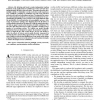Free Online Productivity Tools
i2Speak
i2Symbol
i2OCR
iTex2Img
iWeb2Print
iWeb2Shot
i2Type
iPdf2Split
iPdf2Merge
i2Bopomofo
i2Arabic
i2Style
i2Image
i2PDF
iLatex2Rtf
Sci2ools
TON
2008
2008
Race conditions in coexisting overlay networks
By allowing end hosts to make independent routing decisions at the application level, different overlay networks may unintentionally interfere with each other. This paper describes how multiple similar or dissimilar overlay networks could experience race conditions, resulting in oscillations (in both route selection and network load) and cascading reactions. We pinpoint the causes for synchronization and derive an analytic formulation for the synchronization probability of two overlays. Our model indicates that the probability of synchronization is non-negligible across a wide range of parameter settings, thus implying that the ill effects of synchronization should not be ignored. Using the analytical model, we find an upper bound on the duration of traffic oscillations. We also show that the model can be easily extended to include a large number of co-existing overlays. We validate our model through simulations that are designed to capture the transient routing behavior of both the IP...
| Added | 15 Dec 2010 |
| Updated | 15 Dec 2010 |
| Type | Journal |
| Year | 2008 |
| Where | TON |
| Authors | Ram Keralapura, Chen-Nee Chuah, Nina Taft, Gianluca Iannaccone |
Comments (0)

